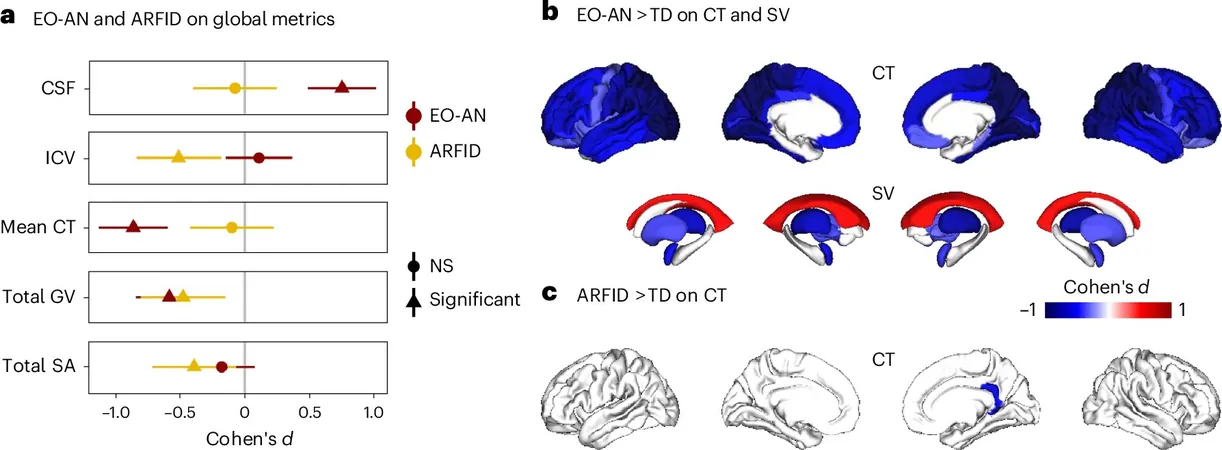
Shocking MRI Study Unveils Distinct Brain Changes in Kids with Eating Disorders
2025-07-16
Author: Li
A Rising Epidemic: The Alarming Surge in Eating Disorders among Children
In a distressing trend, cases of restrictive eating disorders in children—particularly anorexia nervosa and avoidant/restrictive food intake disorder (ARFID)—have doubled over the last ten years. These disorders can lead to dire nutritional deficiencies and hinder essential growth and puberty in young, developing minds.
Unlocking the Mysteries of the Child Brain
Most prior studies concentrated on older individuals, leaving a significant gap in our understanding of how these disorders impact the brains of children. To fill this gap, researcher Clara Moreau and her team launched a comprehensive MRI study involving 290 children, including 124 hospitalized for early-onset anorexia nervosa, 50 for ARFID, and 116 healthy controls—all under 13.
The Distinct Brain Signatures of Eating Disorders
While both EO-AN and ARFID lead to dangerously low body mass indices due to restrictive eating, they arise from fundamentally different psychological roots. EO-AN is driven by a distorted perception of body image, while ARFID stems from sensory aversions to certain food textures or a disinterest in food altogether. Moreau’s groundbreaking research aimed to uncover the unique brain changes linked to each disorder.
Revealing MRI Results: A Closer Look at Brain Structure
In a striking find, children suffering from early-onset anorexia displayed significant cortical thinning, implying serious structural changes in the brain. At the same time, those with ARFID had diminished brain volume and surface area, but their brain changes did not correlate with BMI—as seen in EO-AN. Both conditions showed reduced gray matter volume, yet their differences became stark as the study progressed.
Unexpected Connections with Other Mental Health Disorders
The researchers compared the scans not only between the two disorders but also with brain scans from children diagnosed with ADHD, OCD, and autism. Surprisingly, they uncovered resemblances between EO-AN and OCD, and between ARFID and autism, while no significant connections emerged with ADHD—particularly curious given that past studies indicated a 20% overlap of autism in anorexia and ADHD in ARFID patients.
Paving the Way for Future Research and Treatment
This large-scale MRI study represents a pivotal moment in understanding the brain mechanics associated with these eating disorders. The findings offer critical insight into the unique pathways of ARFID and anorexia, paving the way for more tailored treatment solutions. However, researchers caution that further studies are crucial to address limitations in sample size and to explore brain recovery post-weight normalization.
As we delve deeper into the complexities of these disorders, the hope is that this research will spur effective prevention and treatment strategies for our most vulnerable populations—our children.




 Brasil (PT)
Brasil (PT)
 Canada (EN)
Canada (EN)
 Chile (ES)
Chile (ES)
 Česko (CS)
Česko (CS)
 대한민국 (KO)
대한민국 (KO)
 España (ES)
España (ES)
 France (FR)
France (FR)
 Hong Kong (EN)
Hong Kong (EN)
 Italia (IT)
Italia (IT)
 日本 (JA)
日本 (JA)
 Magyarország (HU)
Magyarország (HU)
 Norge (NO)
Norge (NO)
 Polska (PL)
Polska (PL)
 Schweiz (DE)
Schweiz (DE)
 Singapore (EN)
Singapore (EN)
 Sverige (SV)
Sverige (SV)
 Suomi (FI)
Suomi (FI)
 Türkiye (TR)
Türkiye (TR)
 الإمارات العربية المتحدة (AR)
الإمارات العربية المتحدة (AR)